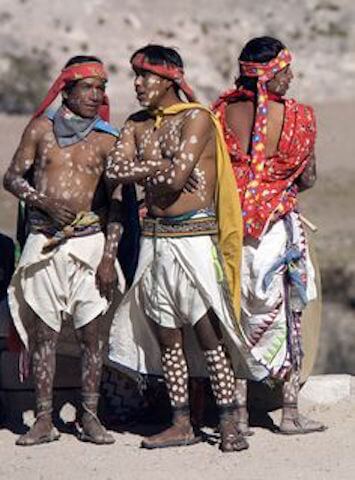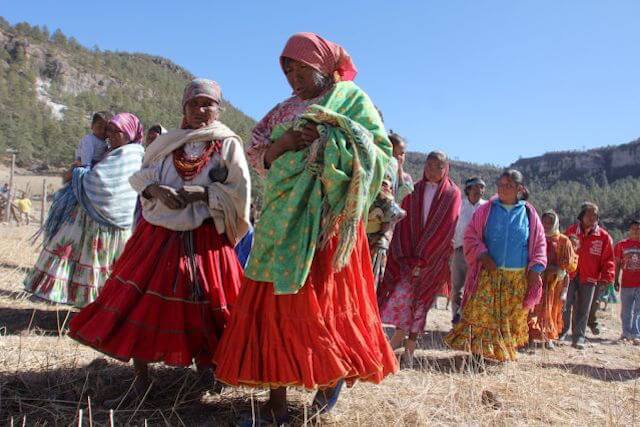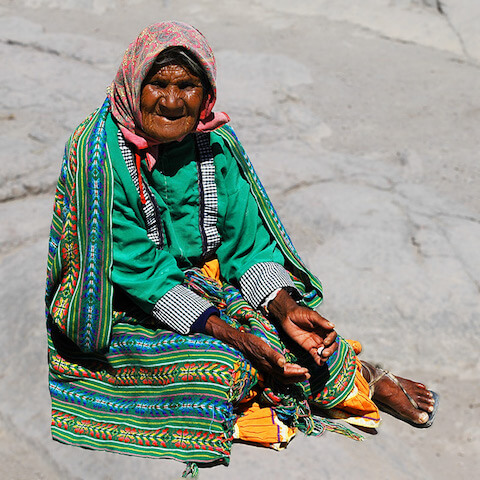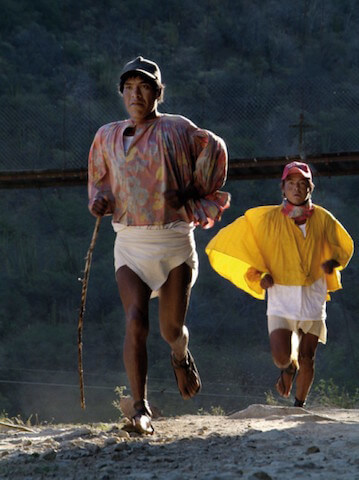According to the legend of the ancient dwellers of the sierra, the
world was created by Rayenari -- Sun God -- and Metzaka -- Moon Goddess.
In their honor, in the present times they dance, sacrifice animals and
drink tesguino. There where the Sierra Madre Occidental becomes rough
and uneven, the Tarahumaras, who call themselves Raramuri (Light Feet),
live. They had arrived there seeking refuge after the arrival of the
Spanish.
The
most important activity among them is growing corn and bean and some
raise cattle. Due to the fragility of their economy some look for work
in the wood mills. The life of this group has changed; the ancient
Raramuri had a balanced diet, besides eating regional fruit and vegeta-
bles, they hunted wild animals. In the present, industrialized products
in their diet might not provide them with all the nutritional
ingredients. Other problems the Raramuri have to overcome are
caciquismo, closing of woodmills, diseases and epidemics, famine,
starvation, and forced labor by mariguana growers, etc.
At
present, the Tarahumara consititute the largest indigenous group in the
state of Chihuahua. The number varies from 50,000 to 75,000 although is
difficult to determine precisely because of the inaccessibility of
the mountains, and the deficient communication links. The Tarahumaras
are spread in the municipalities of Guerrero, Bocoyna, Ocampo, Uruachi,
Chinipas, Guazapares, Urique, Morelos, Batopilas, Guadalupe y Calvo,
Balleza, Rosario, Nonoava, San Francisco de Borja y Carichi. The
mountainous region is divided in two large regions called Alta and Baja
Tarahumara, corresponding the first to the part dominated by the Sierra
Madre Occidental dominates and the second to the area west of the same
sierra, including the zone of the canyons that forms the warm lands of
the state.
The men
are svelte, with strong muscles, recognized as the best long distance
runners. The women are shorter, with oval faces, black and oblique eyes
and straight nose. The men wear a hairband known as "kowera",
huaraches, and loose shirt. The women were a wide skirt and loose
blouse, the hair usually covered with a shawl, and a wool waitband
known as "pukera".
Their
language is sweet and with abundance of words referring to customs and
their environment, with polite words like: "I greet you, as the dove
that warbles, I wish you health and happiness with your loved ones."
Each
house has a hearth and in the bowls they make they cook maize and beans
that were harvested during the season. Among the Tarahumaras everything
belongs to everybody, private property does not exist, so they share
food and housing. They elect a governor - a man who distinguishes for
his services to others and his intelligence -- who in turn elect
gobernadorcillos: priests, shamans, and sages. These go all over their
correspoding towns preaching the pride of being Raramuri, the customs
and morals to uphold; function as judges in problems and are in charge
of prayers.

Fiestas and Ceremonies
All the
commercial liquors are used for fiestas and ceremonies in most places,
but the more primitive groups make their own ritual drinks. Among the
Huichols and Tarahumaras of the northwest it is a corn beer called
tesguino (batari).
As for
clothing, there are innumerable styles of serapes of beautiful texture
and very simply adorned, that are never seen except on the backs of
natives. Notable among these are the tarahumara serapes, heavy and
roughly woven, of natural wool colors, mostly unadorned, which possess
that peculiar beauty derived solely from texture and simplicity.
A
similar trade relationship to the compadres exists among the
Tarahumaras, but the participants are called morawas instead of
compadres, meaning in their language the joining together of two people
who have traded together. When the goods are cattle, the buyer and
seller touch each other's shoulder, saying, "Dios cuida morawa," "God
protect the morawa." And when one morawa visits another, the guests
will be honored with a stool or goatskin to sit on in a preferred place
near the fire.
There
is always a great deal of reserve between the sexes, especially in the
conservative groups. Among the tarahumaras and many others, a man
calling at the home of a friend will make his presence known before
approaching the door of the house, and if the woman is alone he does
not enter but remains at a distance. Unless there is a close
relationship, men and women generally talk to one another only when
necessary and then at a respectful distance with averted faces.

Tarahumara
Dances
The
simple primitive dances of the tarahumaras are still vehicles for all
their prayers. There used to be the rutuburi and yumari, but now both
are combined in the dutuburi, which is danced at all fiestas, on all
ceremonial occasions, as well as for curing the sick and dispatching
the dead. All Tarahumaras have dance patios near their huts and are
constantly giving small and big tesguinadas -dancing, drinking, and
praying parties. To make the prayers effective, an animal must be
sacrificed and his blood offered to Father Sun, who commanded the
people to dance.
Men and
women take part in the dutuburi but dance separately. The women line up
to the right of the chanter, each one holding the left hand of the one
in front with her right hand, and perform a skipping step which begins
with the left foot and ends on the right in a slight hop and stamp.
They dance back and forth and form an arc, while the men walk forward
and backward with the chanter. The chanter repeats a simple refrain to
the steady shaking of his rattle, continuing his singing even when the
dancers stop to rest for long intervals during the night.
This
dance is always performed out of doors, so that Father Sun and Mother
Moon may witness it, and near three crosses, because the dancing and
singing is directed to them as well. Another small cross is placed at
the edge or just outside of the patio when the dutuburi is being danced
to ward off sickness. When food is placed on the altar, a small vessel
of it is put near the cross with the formula, "Sickness is going to
eat; after eating it will go away."
The
peyote dance is also simple but a little different. About ten men and
women take part in it. The women are led into the dance patio by the
two assistant chanters, the men following. Then all dance around a fire
to a tune played on a violin and guitar, at intervals slapping their
mouths and shouting.

The
Tarahumaras also have pascola and Matachine dances, which they had
adopted at some time in the past, and always perform at Catholic
fiestas. The pascolas wear the same rattling tenabari and jingling
belts and do clogging steps like those of the Yaquis, but there the
resemblance ends. On Friday of Holy Week at Samachique one lone
pascola, accompanied by two little boys, enters the church to dance in
the four directions and then continues to the music of a violin and
guitar in the convent patio, where he is given food and tesguino. Later
another pascola may join him. The pascolas also dance for the dead.
The
Matachines dance in greater numbers and seem to be more important,
their organization and costumes differing in the various villages.
Those of Samachique dress more elaborately than others. They wear a red
cloth cape with a blue or white lining, reaching to the knees, over an
ordinary white cotton shirt; two pairs of trousers, the red outer ones
cut so at the knees that the white pair shows bagging; a belt from
which hang red bandannas in front and back; long colored stocking and
real shoes of any kind available. The crowns made of thin wood or bark
and the arch formed of curved sticks are covered with colored paper,
mirrors and other shining things, and fitted on the head over a red
bandanna tied under the chin. In the right hand they carry a rattle and
in the left an adorned wooden wand.
The
dance formation and steps are similar to those of the Yaquis. They also
have a monarca, who stands in front between the two lines and indicates
all the movements with his wand, and all the dancers beat the rhythm as
they form their figures to the music of violin and guitar.
The
Tarahumara Matachines are not organized like the Yaqui, but in
Samachique each dancer is in charge of a chapeon, who stands to one
side of him, marking the rhythm of the dance and shouting the changes
in figures in falsetto. The leader of the chapeones wears a wooden mask
on the back of his head, painted in white lines, with false white hair
and beard. This man holds a position of respect in the community; he
often dedicates the tesguino at fiestas and sits with the judges when
they are trying offenders.
There
seems to be no explanation as to why these men are called chapeones,
unless there is some remote relation between them and the capeos,
Spaniards who used to fight bulls without weapons at certain fiestas.
In New Mexico there are chapeones under different names, who pantomime
bullfighting in the Matachine dances.
The
name matachin is also of Spanish origin. In ancient times it was
applied to gay masqueraders, wearing masks and long vari-colored robes,
who danced and made merry, dealing blows with wooden swords and
bladders filled with air. But those are a far cry from the Matachines
of today in their ritual dances.
The
mitote is their sacred instrument and is played only for the corn
rites. The players are generally old medicine men. One from the village
of San Francisco, Nayarit, said that the mitotes are made by God in
heaven and sent to earth; that he knew how to play at birth because God
had taught him. But his father and grandfather had been mitote players.
The fathers teach their sons music, as all the other arts.

For more
information about the Tarahumara, contact:
Delegation INI Chihuahua
Coronado 1413
Col. Sta. Rita
Chihuahua, Chihuahua
Mexico Fundacion Tarahumara -
Jose A. Llaguno, A.B.P.
Daniel Zambrano 518-8
64030 Monterrey, N.L.
México.
Tel. y Fax: Monterrey N.L.: (528) 347 5299
Fax: (528) 346 3977
Cd. de México: (525) 641 4973
FICINA PRINCIPAL
Daniel Zambrano
# 518-Depto. 8 Col. Chepe Vera
Monterrey, N.L. 64030
Tel:
(918) 347 52 99 Fax: 346 39 77
OFICINA
MEXICO
Prol. Niños Héroes # 259
Tepepan, México, D.F. 16070
Tel. y
Fax: (915) 641 49 73

Tarahumara Frog

Tarahumara Mountain Kingsnake
References:
"Mexico's
Sierra Tarahumara: A Photohistory of the People on the Edge",
by W. Dirk Raat and George
Janecek (1998), Univ. of Ok. Press.
Article
in the MAGAZINE entitled "Wooden Promises".
Bernard
L. Fontana, Tarahumara,
Where Night is the Day of the Moon, University of
Arizona Press .
John G.
Kennedy, Tarahumara of the Sierra Madre, AHM Publishing.
"The
Tarahumaras: Mexico's Long Distance Runners",
National Geographic, May 1976.
M. John
Fayhee, Mexico's Copper Canyon Country,
A Hiking and Backpacking Guide to Tarahumara-land, Cordillera Press.

 Return to Indigenous Peoples' Literature
Return to Indigenous Peoples' Literature
Compiled by: Glenn Welker
ghwelker@gmx.com
Copyright @ 1993-2016
This page last updated 08/01/2016 04:34:33
This site has been accessed 10,000,000 times since February 8, 1996.









